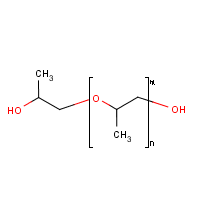Polypropylene glycol
Agent Name
Polypropylene glycol
CAS Number
25322-69-4
Formula
(C3-H6-O)mult-H2-O
Major Category
Plastics & Rubber

Synonyms
Actocol 51-530; Alkapal PPG-1200; Alkapal PPG-2000; Alkapal PPG-4000; Bloat guard; Desmophen 360C; Emkapyl; Glycols, polypropylene; Jeffox PPG 400; Laprol 2002; Lineartop E; Methyloxirane homopolymer; Napter E 8075; Niax 1025; Niax 11-27; Niax 61-582; Niax polyol ppg 4025; Niax ppg; Niax ppg 1025; Niax ppg 3025; Niax ppg 425; Oopg 1000; Oxirane, methyl-, homopolymer; P 400; P 4000 (polymer); P.P.G 2025; P.P.G 3025; P.P.G 4025; P.P.G. 1000; P.P.G. 1025; P.P.G. 1200; P.P.G. 150; P.P.G. 1800; P.P.G. 400; P.P.G. 425; P.P.G. 750; PPG; Pluracol 1010; Pluracol 2010; Pluracol P 2010; Pluracol P 410; Poly(oxy(methyl-1,2-ethanediyl)), alpha-hydro-omega-hydroxy-; Poly(propylene oxide); Polyglycol P 400; Polyglycol P-2000; Polyglycol P-4000; Polyglycol type P1200; Polyglycol type P2000; Polyglycol type P250; Polyglycol type P3000; Polyglycol type P400; Polyglycol type P750; Polymer 2; Polyoxypropylene; Polyoxypropylene glycol; Polypropylene glycol; Polypropylene glycol #1200; Polypropylene glycol #400; Polypropylene glycol #425; Polypropylene glycol #750; Polypropylene glycol 1025; Polypropylenglykol [Czech]; PPG-15; Propylan 8123; Propylene oxide homopolymer; Propylene oxide, propylene glycol polymer; SKF 18667; Voranol P 1010; Voranol P 2000; Voranol P 4000; alpha-Hydro-omega-hydroxypoly(oxy(methyl-1,2-ethanediyl)); alpha-Hydro-omega-hydroxypoly(oxypropylene); [ChemIDplus]
Category
Polymers
Description
Clear, oily liquid; [HSDB]
Sources/Uses
Used for solvents, plasticizers, softening agents, antifoaming agents, mold release agents; Also used to make resins, surface active agents, adhesives, coatings, polyurethane foams, polyurethane high-performance elastomers, polyurethane sealants for clay pipe; [HSDB]
Comments
In animal experiments, low molecular weight propylene glycols, e.g., P400, P750, and P1200) are potent CNS stimulants; Propylene glycols with higher molecular weights, e.g., P2000, are of low toxicity by any route of exposure; [HSDB] May cause irritation; [MSDSonline] ". . . PPGs are not believed to present a significant hazard to health in the workplace environment." [AIHA]
Biomedical References
Exposure Assessment
Explanatory Notes
Flash Point varies from 390 to 495 deg F, depending on molecular weight; [CAMEO]
WEEL
10 mg/m3
Adverse Effects
Neurotoxin
Other CNS neurotoxin
Diseases, Processes, and Activities Linked to This Agent
Other Information
No other related information on this agent was found.